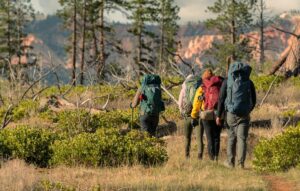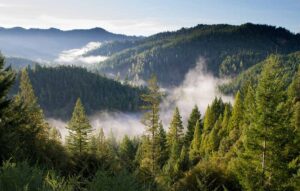
The Current State of the Earth’s Ozone – From the 1980s to Now
Ask anyone in 1985 about the state of our ozone layer, and they’d tell you one thing for certain: we have a big problem. After the rampant use of products containing manmade chemicals called chlorofluorocarbons (or CFCs) throughout the 1970s and 80s, largely in aerosols and industrial processes, scientists discovered a hole in our ozone layer. A big one. And it was becoming progressively worse by the day.
Experts warned about the possible consequences, the fragile and volatile nature of our ozone’s composition, and the resulting increase in ultraviolet radiation that would put all life on Earth at risk.
Our ozone layer absorbs 97% – 99% of the ultraviolet radiation from the sun. When the ozone layer becomes too thin, or worse, a hole appears, too much ultraviolet radiation is able to reach the Earth’s surface. This can impact humans, plants, and animals on multiple levels, slowing photosynthesis in plants and delaying growth, dramatically increasing the risk of skin cancer for humans and animals, and even leading to the concentration of smog and increased acid rain in urban areas.
In the 1980s, the discovery about changes to our ozone layer may have been new, but scientists could all agree about the looming risks posed by the hole hovering over Antarctica.
Working Together to Close the Gap (1990s)
As scientists studied the ozone hole, they discovered that it was seasonal, forming sometime between September and October every year due to a decrease in ozone levels resulting from unique polar atmospheric conditions above Antarctica. A second, smaller hole, believed to be caused by similar conditions, was also discovered over the Arctic.
Scientists came to identify chlorofluorocarbons and other “ozone-depleting substances” as the primary culprits of ozone decay, largely based on the work and theories of American chemists F. Sherwood Rowland and Mario Molina, who later won the 1995 Nobel Prize for Chemistry alongside Dutch chemist Paul Crutzen as a result.
In 1987, an international treaty titled the Montreal Protocol on Substances that Deplete the Ozone Layer was signed into effect by world leaders, with global enforcement beginning in 1989. This agreement outlined the global reduction and elimination of the use of CFCs. The 1990 London Amendment updated this treaty to call for the complete phaseout of CFCs, halons, methyl chloroform, and carbon tetrachloride (all ozone-depleting substances) by 2015 for all countries.
As a result of this global collaboration, something spectacular happened… the ozone layer began to recover and the hole above Antarctica began to shrink.
The Current State of the Ozone Layer
As of today, NASA actively monitors the ozone hole on a daily basis, and they—alongside scientists at NOAA—believe the ozone layer (and the hole above the Antarctic) is on track for full recovery by 2066. For the hole above the Arctic, it’s projected that it should close by 2045.
Since the Montreal Protocol was signed, the world has successfully phased out the use of 99% of the chemicals and substances identified as ozone depleting.
Ozone action sets a precedent for climate action. Our success in phasing out ozone-eating chemicals shows us what can and must be done – as a matter of urgency – to transition away from fossil fuels, reduce greenhouse gases and so limit temperature increase.
Secretary-General Petteri Taalas, World Meteorological Organization
Experts agree, the Protocol has also helped us avoid an additional 0.5°C of global warming—a number that’s even more significant given 2024 was the first year increased global surface temperatures nearly surpassed the threshold of 1.5°C set by the Paris Agreement (2016), and the impacts of climate change are already being felt all over the world.
Moving Forward
Where does that leave us?
As far as the ozone layer is concerned, we still have a way to go before we can consider the crisis to be fully averted. While there are certainly opportunities to accelerate ozone recovery by shifting toward more sustainable agriculture and food systems and by retiring equipment and machinery that still utilize ozone-depleting chemicals, we must also consider the role of greenhouse gases in our atmosphere.
Greenhouse gases trapped in our atmosphere impact how well and how quickly the ozone layer, located in the stratosphere, is able to recover. Other climate-related (often manmade) factors are also at play. Wildfires, for example, are becoming larger and larger every year, and can send particulates into the stratosphere, impacting the unstable molecules in our ozone. Simultaneously, civilian space exploration leaches emissions from rocket engines directly into the upper atmosphere, and satellites sent into space burn up during re-entry, leaving harmful gases and debris behind that interfere with the ozone’s recovery.
The ozone hole remaining open has an equally negative impact on climate change as additional heat and ultraviolet radiation from the sun advance global warming, sea level rise, and damage ecosystems on land and at sea.
Whether we’re talking about climate change or ozone recovery, the tasks set before us remain the same. If we want our world to be livable in the future (not for some far-off generation, but for today’s children and young adults), then we must reduce and, ultimately, eliminate our reliance on fossil fuels by transitioning to sustainable agriculture and food systems, renewable energy, sustainable manufacturing, and more.
It’s not an impossible task. Look at the Montreal Protocol, we’ve done it once before! When countries come together for the benefit of the planet, great things happen. The tools exist, the opportunity exists, now it’s time to demand rapid action.
Use this link to find your representatives and DEMAND climate action NOW!
Featured articles
ed to combat environmental racism, WE ACT for Environmental Justice (West Harlem Environmental Action) aims “to build healthy communities by ensuring that people of color and/or low-income residents participate meaningfully in the creation of sound and fair environmental health and protection policies and practices.” This manifests in a wide variety of actions bridging environmental protection and public health: advocating for climate justice and equitable urban planning while supporting community solar-energy initiatives, and so much more.





